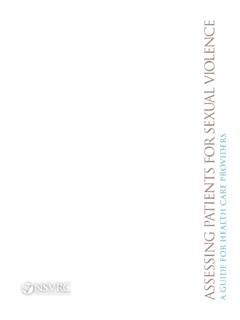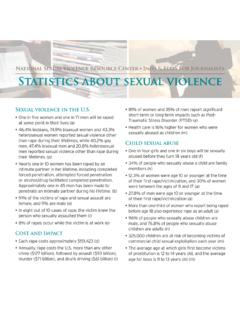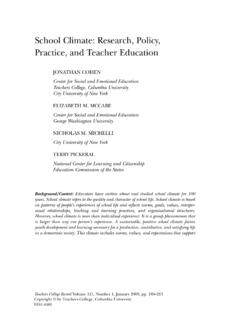Transcription of Risk Factors for Child Sexual Abuse
1 Risk Factors for Child Sexual Abuse Annotated Bibliography The following annotated bibliography features articles on risk Factors and characteristics associated with Child Sexual Abuse perpetration. The bibliography provides research on Child Sexual Abuse (CSA) perpetrators as a general population, as well as special perpetrator populations such as females, juveniles, pedophiles, and sexually reactive children. GENERAL Center for Sex Offender Management. (2000). Myths Becker, J. V. (1994). Offenders: and facts about sex offenders Characteristics and treatment. [Fact sheet]. Retrieved from The Future of Children, 4, 177-197. This fact sheet confronts common Becker reviews research on myths about sex offenders, including Child Sexual Abuse perpetrators, but not limited to Child Sexual highlighting the role of deviant Abuse perpetrators.
2 The document Sexual interests and behaviors in addresses misconceptions about sex perpetration. Becker discusses offender recidivism, sex offense rates, characteristics of Child Sexual Abuse motivations for Sexual offenses, sex perpetrators, problems in determining offender demographics, and the role of recidivism rates, and the ef cacy childhood Sexual Abuse as a risk factor of Sexual offender treatment for perpetration. measures. CSA perpetrators are a diverse group in terms of both Cortoni, F., & Marshall, W. L. (2001). background and perpetration acts, Sex as a coping strategy and its but many share traits in common, such relationship to juvenile Sexual history as paraphilias (socially unacceptable and intimacy in Sexual offenders.)
3 Sexual practices), a history of physical Sexual Abuse : A Journal of Research and Treatment, 13, 27-43. and/or Sexual Abuse , and early onset of deviant Sexual interests. Research suggests that multiple variables, Cortoni and Marshall analyzed rather than a single variable, data from the Coping Using Sex increase risk of Child Sexual Abuse Inventory (CUSI) to nd correlations perpetration. between sex-related coping strategies NSVRC 123 North Enola Drive, Enola, PA 17025 Toll free: 877-739-3895 Trauma, Violence, & Abuse , 1, 250-263. The authors hypothesize that Sexual offending is rooted in an offender's poor childhood attachments to his/her parents. A poor Child - parent relationship increases the Child 's risk of being sexually abused, which increases the likelihood of the Child using masturbation and sex as a coping strategy later in life.
4 The use of sex as a coping strategy has been correlated with adult Sexual aggression, and when coupled with conditioning processes that reinforce Sexual and Sexual offending. The authors found that deviancy, makes Sexual offending more likely. rapists and Child Sexual Abuse perpetrators Stirpe, T. S., & Stermac, L. W. (2003). An were signi cantly more likely to demonstrate exploration of childhood victimization and family- Sexual preoccupation during adolescence, which of-origin characteristics of Sexual offenders motivated the use of sex as a coping strategy later against children. International Journal of Offender in life. Research data also suggested that intimacy Therapy and Comparative Criminology, 47, 542- de cits and loneliness contributed to greater use 555.
5 Of Sexual activity as a coping mechanism. Stirpe and Stermac compared the childhood Finkelhor, D., Turner, H., Ormrod, R., Hamby, victimization experiences reported by 33 Sexual S., & Kracke, K. (2009). Children's exposure offenders against children, 66 violent non- to violence: A comprehensive national survey Sexual offenders, and 25 non-violent non- Sexual (NCJ 227744). Washington, DC: Of ce of offenders. Sexual offenders against children Juvenile Justice and Delinquency Prevention. reported signi cantly more childhood Sexual Retrieved from les1/ Abuse , Sexual propositioning, and exposure to sex than subjects in the other two groups. Sexual This document discusses results from the National offenders against children were also more likely Survey of Children's Exposure to Violence to report physical discipline as the primary type of (NatSCEV), conducted between January and May discipline in their childhood household.
6 2008. Drawing upon a study of 4,549 minors age Terry, K. J., & Tallon, J. (2007). Child Sexual Abuse : 17 and younger, the authors found that percent A review of the literature. New York, NY: John Jay of children surveyed had been sexually victimized College of Criminal Justice. Retrieved from http://. in the past year and percent over their lifetimes. Finkelhor et al. also measured rates of This literature review provides an overview of the physical assault, bullying, Child maltreatment, and body of academic works on Child Sexual Abuse . exposure to violence against others. The authors explore estimates of Child Sexual Abuse , theories and etiology of Child Sexual Abuse , Marshall, W. L., & Marshall, L. E. typologies of perpetrators, sex offender evaluation (2000).
7 The origins of Sexual offending. 2 Risk Factors for Child Sexual Abuse and treatment, and Child Sexual Abuse within FEMALE Sexual OFFENDERS. speci c organizations ( , Boy Scouts, Catholic Church, athletic organizations, etc.). Center for Sex Offender Management. (2007). Female Sex Offenders. Retrieved from http://www. Whitaker, D. J., Le, B., Hanson, R. K., Baker, C. K., McMahon, P. M., Ryan, G., Klein, A., & Rice, D. D. (2008). Risk Factors for the perpetration This article discusses issues surrounding female of Child Sexual Abuse : A review and meta- Sexual offenders. The document presents analysis. Child Abuse & Neglect, 32, 529-548. statistics on female Sexual offending, arrests, and representation in sex offender treatment programs.
8 Additionally, it explores sociocultural Whitaker et al. reviewed 89 studies published and systematic Factors underlying the under- between 1990 and 2003 on CSA perpetration recognition of female Sexual predation. It details risk. The authors examined six categories of characteristics, risk Factors , and typologies for risk Factors : family risk Factors , externalizing adult and adolescent female Sexual offenders, behaviors, internalizing behaviors, social de cits, contrasting these to male Sexual offenders. Sexual problems, and cognitions tolerant of Sexual violence. The authors found that Sexual offenders Grayston, A. D., & De Luca, R. V. (1999). who targeted children demonstrated substantial Female perpetrators of Child Sexual Abuse : A.
9 Differences from non-offenders in all six categories. review of the clinical and empirical literature. Also, Sexual offenders who targeted children did Aggression and Violent Behavior, 4, 93-106. not differ signi cantly from Sexual offenders (98)00014-7. who targeted adults, except that the former Grayston and De Luca review the body of clinical showed lower rates of externalizing behaviors ( , and empirical literature on female perpetrators aggression/violence, substance Abuse , non-violent of Child Sexual Abuse , exploring areas such as criminality, etc.). prevalence, characteristics of victims, and common characteristics of perpetrators. Young, M. H., Justice, J. V., & Edberg, P. (2008). Sexual offenders in prison psychiatric treatment: A Oliver, B.
10 E. (2007). Preventing female- biopsychosocial description. International Journal perpetrated Sexual Abuse . Trauma, Violence, &. of Offender Therapy and Comparative Criminology, Abuse , 8, 19-32. 52, 1-21. Oliver provides an overview of female Sexual Young, Justice, and Edberg evaluated 120 males offenders and reviews the body of literature on (60 Sexual offenders and 60 non- Sexual offenders). female-perpetrated Sexual Abuse . The author in prison psychiatric treatment using psychological, explores possible reasons why female Sexual neuropsychological, and sociological/demographic offending is under-recognized in society and measures. The authors found that Sexual offenders how Sexual stereotypes contribute to this under- displayed signi cantly more neuropsychological recognition.

















